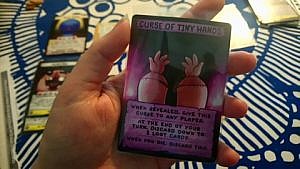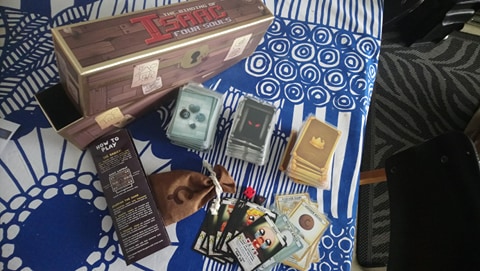I’ve been a bit of a fan of The Binding of Isaac and its sequel Rebirth ever since the first game was first released, to the point where the two have a combined over one thousand hours on my Steam account. It was inevitable, then, that when a Binding of Isaac card game was announced, I immediately threw my money at the Kickstarter.

The box arrived quite promptly considering this was a Kickstarter project – the main reason being the game had essentially already been completed and the campaign was just to fund production. It then sat on the shelf in my apartment until I finally pestered one of my roommates and her boyfriend to play it with me. The reason it took pestering? The aesthetics of the game. My roommate was aware of the gross-out monster designs of the computer game and dislikes them: there’s a lot of poop, blood, and body horror about. This aesthetic has been translated into the card game as well, and though there are slight attempts to hide ickier monsters in shadows, the distinctive style has mostly not been compromised.
The game plays out in a fairly straightforward manner; the mechanics ended up reminding us of Munchkin and Magic: the Gathering. Everyone draws from a loot deck containing minor trinkets, uses money to buy more powerful treasures, and fights both monsters and tougher bosses by rolling dice. Unlike in the computer game, dying doesn’t set you back to square one; instead, the player takes a “death penalty” that forces them to discard and deactivate beneficial items, and play continues. Once a player has collected the titular four souls, most typically through killing boss enemies, they win the game. The other players can try to prevent this by using items to mess with others’ turns and actions, similarly to how instants work in Magic (the stacking of effects even works the same way). There’s a great variety in enemies and items – the game even sold its Kickstarter with the phrase “it has a lot of cards”. More expansions for the game are planned, similarly to how the computer games got several expansions, so this will certainly become even more the case in the future.
The curveball comes in the rulebook, at least for those of us who play a lot of board games. In one throwaway sentence, the rulebook encourages players to barter amongst themselves: an example given is one player being about to die while fighting a monster and another suggesting they can prevent their death if given, say, three coins. Since this is such a minor footnote in the rules, my playtest games featured none of it: we were so used to playing by normal board game rules where nothing changes hands unless specifically prompted that it didn’t cross our minds. Another irritating footnote in the rulebook is that a significant portion of it is, in fact, online. The online rules clarify some things, but actually make some rules harder to parse and even directly contradict themselves in at least one case.

Mechanically, the game seems sound enough at first glance, but through a few play sessions its weaknesses became very evident: there is little to no catch-up in the mechanics and players are easily left with nothing to do if the loot deck doesn’t provide them with options. Once a player gets items that make defeating monsters and therefore obtaining souls easier, it’s difficult for other players to catch up to them, as each victory gives them more items to make future fights even easier. In both playtest sessions, one player spent most of their playtime just passing their turn to the next player because they didn’t get any items that would help with fighting monsters and didn’t think the odds could turn in their favor without them. The only real strategy to prevent snowballing is all other players banding together to try and prevent the player in the lead from succeeding further. Some of the player characters, which are randomized at the start of the game, are also clearly stronger than others and some are painfully situational.
All in all, The Binding of Isaac: Four Souls is not a bad game. It could use some added rules that allow players to play catch-up more easily, some trackers and tokens for certain effect triggers, and more emphasis on the bartering and backstabbing elements, since the game creators clearly consider them a significant element of the game. As it stands, the game is a decent enough card game that absolutely should not be played with the recommended two to four players – our three-player setup was just about functional, but the game seemed like it would be a nightmare to play as a duel and we saw no other reason to not play with up to six players than the game possibly running out of coin tokens. Its major double-edged sword is that it’s clearly made for fans of the computer game with its items and enemies taken from the source material. If you dislike Binding of Isaac or haven’t heard of it, Four Souls might not be interesting enough to get you to try it.
————
Publisher: Studio71
Designers: Edmund McMillen, Danielle McMillen, Tyler Glaiel
Artists: Tikara, Rojen241, Wormchild, KrystalFlamingo
Genres: Card Game
Players: 2-4
Age Suggestion: 13+
Play Time: 30-60 minutes
